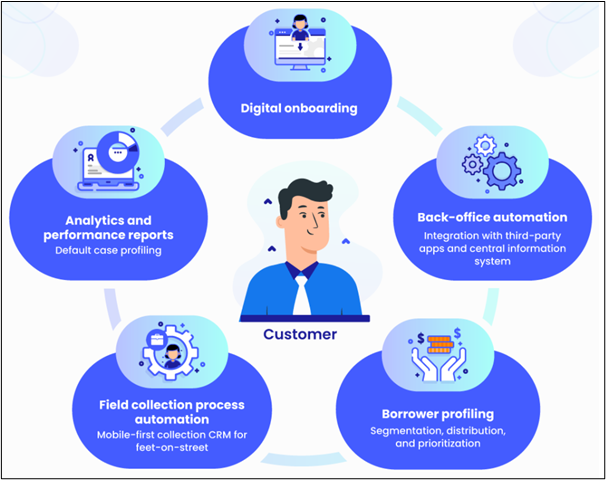To begin with, Debt collection is the forefront of every lending business as it directly supports the revenues of a company. With the growing consumer market and the affinity of today’s consumers, debt management becomes an important opportunity for the lenders, making bad debts a probable side effect of the industry.
Bad debts being a serious concern amongst the lenders has ensured that the collectors become a company’s frontline workers in the debt collection industry. They are the first point of contact for debtors. For the same reason, companies allocate a lot of funds in training their collectors to improve their productivity to ger more returns for the company.
Debt collection used to be a call and respond industry where the collectors would make efforts in calling the debtors and any automated process would still involve a human interference thereby increasing the human error rate. According to the recent data, consumer debt has increased nearly by USD 2.3 trillion (2019) since the Great Recession in 2009 in the United States. The COVID-19 pandemic is making it even more difficult to recover debts for the entire globe.
Today, more automated tools are available in the market to improve this process and get better results. Artificial intelligence (AI) tools, such as automated chatbots, interactive voice response systems, opt-in short message service (texts) and website portal negotiators, have grown exponentially in the debt collection industry. Lenders have noticed that with the right process and tools, these businesses are able to manage accounts and reduce Days Sales Outstanding (DSO) effectively.
Debt Collection Automation Process:
In a lot of cases, lenders spend a lot of time, money, and resources in chasing the default cases which in turn becomes a major overhead in the lending business. Loan recovery also becomes a major challenge because of the manual work involved in the collections cycle. Some of the manual task
- Manually calling the borrowers because the call centres are not adept
- Manually maintaining records of the defaulters
- Using violence as a method to recover the debts, thereby spoiling relationship between the lenders and the borrowers
- Not approaching the borrower on all the mediums that she/ he are available
- No proper record or track of collection agents in the field
Therefore, it only makes sense to find a simple solution which automates the entire journey and eliminates any error or negative relationships with the borrowers, thereby, showing empathy on the part of the lenders. This automation in loan recovery can be done by lenders by using a a debt collection CRM or outsourcing the same in order to streamline the entire process. This method is proven to improve the ROI of the lenders. Below is an infographic to explain the Debt Collection Automation Process.

Source: LeadSquared
When we talk about automation, let us understand what all it entails. General Requirements for the functionality of a debt collection system should contain:
- Tools that provide the opportunity to get analytical and accurate information on the overall effectiveness of the company along with the individual debtors
- Utilizing tools in order to personalize communication for every individual debtors, for example, which platform to focus on, which mode of communication to use, etc
- Tools for the implementation of management activities (friendly user interface)
- Credit and collections software optimised for all stages of the delinquency cycle for collection efficiency
- High-quality negotiation techniques such as voice-to-text quality check, emotion detection and skill-based call routing are prescribed
- Greater scalability and quality control for cost optimisation
At the top of the activities done through automation involve:
- Automatically generating calling and following up lists for the operations team
- Safeguarding the lenders through potential risks with advanced fraud management solutions
- Custom payment link is generated for added security
How does automation help in improving the debt collection process?
- Increased response: The advantage of having chatbots and outbound calling systems is that it is helping lenders reply to the borrowers and their queries in a timely manner. The borrowers are even given an opportunity to reach out to the customer support team. This helps in reducing the burden on the customer support executives as a lot of queries are resolved by the chatbots.
- Optimize resources: AI can help analyze the collection trend and pattern in order to find out which associate is good at which kind of debt recovery and thereby evaluate the time and other details on the customer’s accounts. This paves the way for quicker response of accounts and spending time on the accounts where it is required.
- Automatic payment reminders: It is advisable to not wait till the last date to remind a borrower and hence periodic updates on the same should be sent. This helps in having a more effective mental engagement and letting borrowers know that the payment due date is around the corner. If by any chance a borrower misses a payment, then the lenders can follow-up with them through an automated outbound call which prompts the user to select their desired option.
- Ensures compliance: When we say compliance, it means the worst case scenario when the lender has to initiate any legal actions against a borrower for not being able to live upto the loans taken. In this process, an automated debt collection system ensures that the right procedures and relevant laws are abided by. Since everything is recorded automatically, it ensures that the lender also has the progress report of the borrower along with the entire compliance report.
Potential advantageous outcomes of automation for debt collection that can be foreseen
Automation helps in monitoring debtor activities, debtors financial outlook, spending patterns, and so on, thereby eliminating clerical work.
- Helping lenders get a deeper understanding of the customer defaulters with the help of more advanced systems
- Automated transactions help in reducing the overall time and investments, and improving customer service
- Potential defaulters can be identified using Machine learning (ML)
- Since Virtual Assistants reply to the customers, providing an opportunity to automate non-revenue generation-based transactions, this significantly reduces the flood of unproductive queries handled by agents and they can in turn invest their time on more sensitive task
Debt collection not only helps in getting back the amounts from borrowers, but it also helps in recommending a way out of a crisis, and automation can act as a bridge between the lenders and the customers. Automated solutions can potentially transform the way collections are taken care of, subsequently helping the lending firms improve customer experience and create rapid business value. Since debt collection is a very dynamic world, there are chances that we get to see a lot more advanced technology and more changes in this regard, making it ten times more convenient for both the borrower and the lender. Self service portals is one such step ahead in this domain.


 International (EN)
International (EN) India (EN)
India (EN)


